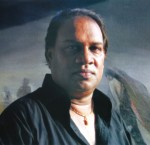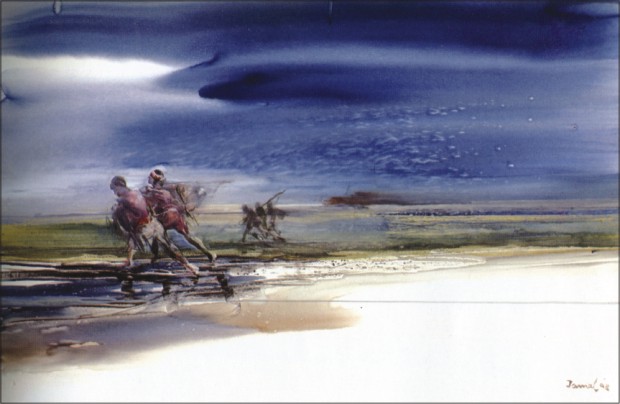| Home - Back Issues - The Team - Contact Us |
 |
| Volume 10 |Issue 14 | April 08, 2011 | |
|
|
Art CoolandConfident Fayza Huq
Jamal Ahmed, known for his bronzed, glistening human figures, talking about his recent work, sitting at the staff-room of “Charukala”, says, “I'm doing charcoal painting touched with pencil. I use live figures because then the emotion and feelings of the subject can be felt by the painter. Master painters all over the world use live models, rather than photographs.” Asked how he gets the special bronzed effect, he says that he uses acrylic at first and then applies pastel on top, which is then left to dry. Another area of excellence for this versatile artist is landscapes and Jamal says that along with figure drawing, he enjoys doing river banks and hills too. Landscapes are elements which in student days one visited and drew from what one saw around. Apart from memory, he sketches a bit, and uses photographs, if necessary. Today, Jamal paints from memory, at leisure, in his studio, at Elephant Road. Thus, with decades of painting and teaching, Jamal has his reservoir of canvases at his beck and call – to please a patron. Riverbanks have always held a fascination for Jamal: “When I was young, I went to the banks of the Padma, as my hometown is in Manikganj. Today when I go overseas, I naturally visit the riverbanks to get the feel of Mother Nature which philosophers and physicians say is essential for the preservation of health.”
When he was in Japan for four years till 1986, he learnt certain techniques, which he found useful. When in Poland from 1980- 81, earlier, his stay overseas was once again very informative. The classes that he took in Italy and Norway, also proved very useful. Sometimes, he says, unconsciously ideas and feelings filtered into his being and mind. This kind of learning through meeting others from beyond one's own world shaped his sensations and emotions, he says. Delving into the subject of the call of the art market, Jamal says that at times one has to do commissioned work, when it is necessary, but often he does whatever pleases him. “I might paint a dustbin; I might go in for a nude or even a mad man, portrayed as if his neck has been chopped off; these are for my own inner drive,” says Jamal. Asked if artists today can make a living by painting alone, Jamal says that today there are so many galleries and connoisseurs, that young artists today can make a fair living, Also he points out, there are many new TV channels, which require artists. Again there are many activities that require interior decorators and furniture makers, and these too absorb artists and use their artistic sensibilities. True, he says, this is not pure painting, but there is book cover designing and illustration of books, which will keep artists from being in hovels. During his time, in the mid eighties, there was no such wide scope of being absorbed.
Jamal says, due to the support given to him by his friends and family, it was fairly easy for him to forge ahead. His marks at school were best at drawing. His father was broadminded. During school days, at the Art College, he was accompanied by Shahabuddin, who came to the nearby venue of Kalabagan, and the two trooped off together. When Shahabuddin went off to Paris, he was guided and encouraged by other young teachers of “Charukala”, like Shahid Kabir – who spent his time between Spain and Dhaka – Mahbubul Amin and Mahmudul Haque. Side by side, senior teachers , who saw his work outside class, as in the case of Shafiuddin Ahmed and Mohammad Kibria, inspired him, having long 'table talks' and occasional tête-à-têtes about how to improve his work. Among the masters, says Jamal, it is Zainul Abedin and Quamrul Hassan that he admired most of all. “As for Shahabuddin , I've always liked his work. I find him dynamic though some have said he creates to please his buyers. His treatment of white is superb, I feel,”he says. Asked if he felt that the trio Zainul, Shafiuddin and Quamrul Hasan have successors who are as remarkable as them, Jamal says, that Bangladeshi artists today have won the admiration of the world over such as the US, Europe and Japan.Young artists have won admiration in Venice, Japan, Korea and in the subcontinent; the young artists, who are under 50, have won many praises. Jamal believes that work cannot be without an emotional drive. “One must feel from one's innermost being that the image in mind must be presented with passion. If one does not enjoy painting the subject, the result is simply a craftsmanship which will take the colours of one's inward emotions," says Jamal. What gives him more sense of satisfaction his painting or teaching? Jamal says that if he can teach the students what he has learnt over the years, sitting at the feet of master painters and exchanging ideas with his peers, he will feel he has achieved something worthwhile. “I want my students to be better than me," says Jamal, who has been teaching for over two decades.
Copyright
(R) thedailystar.net 2011 |



